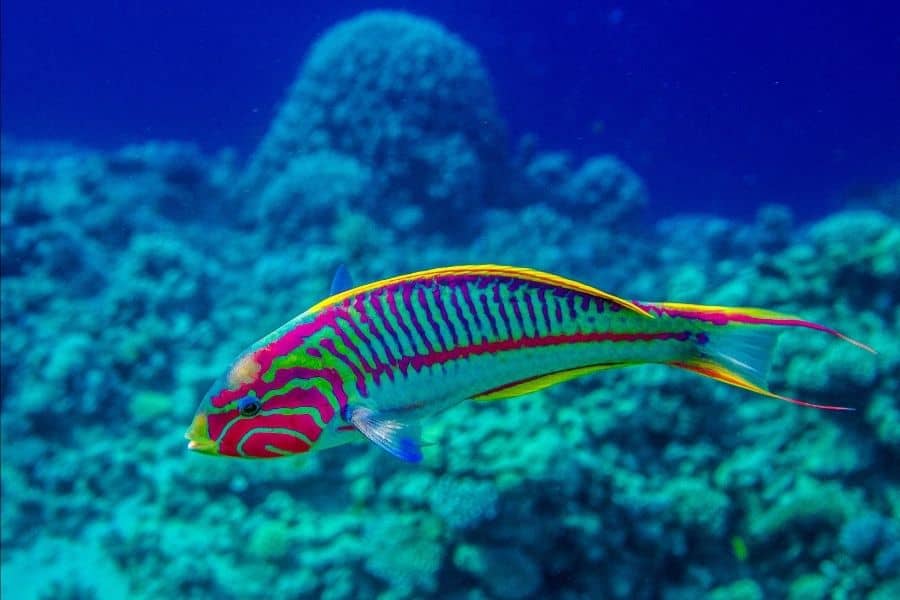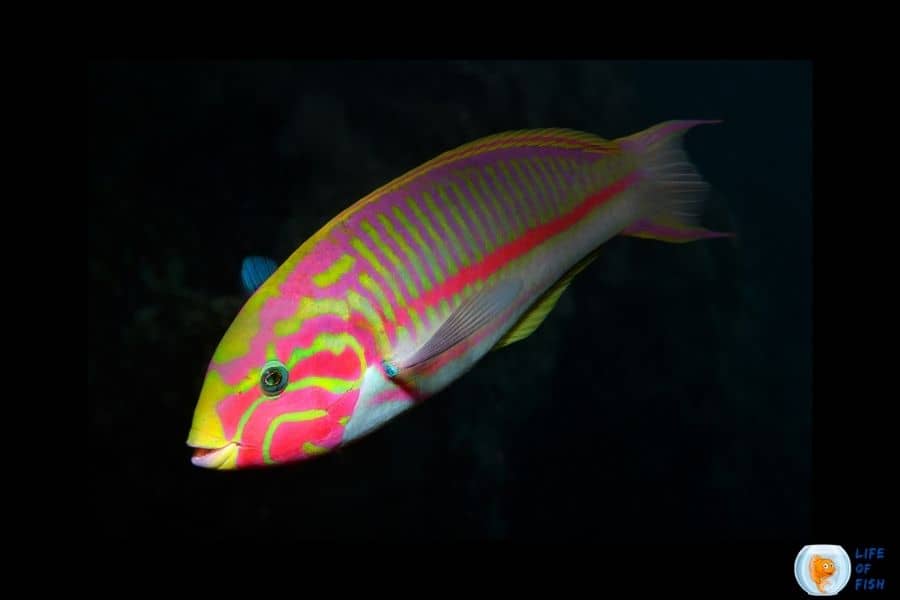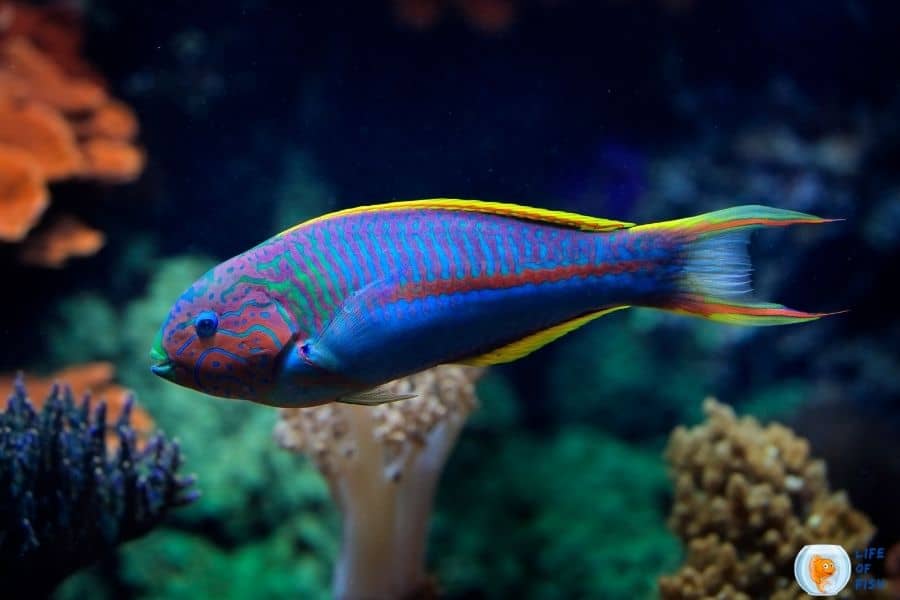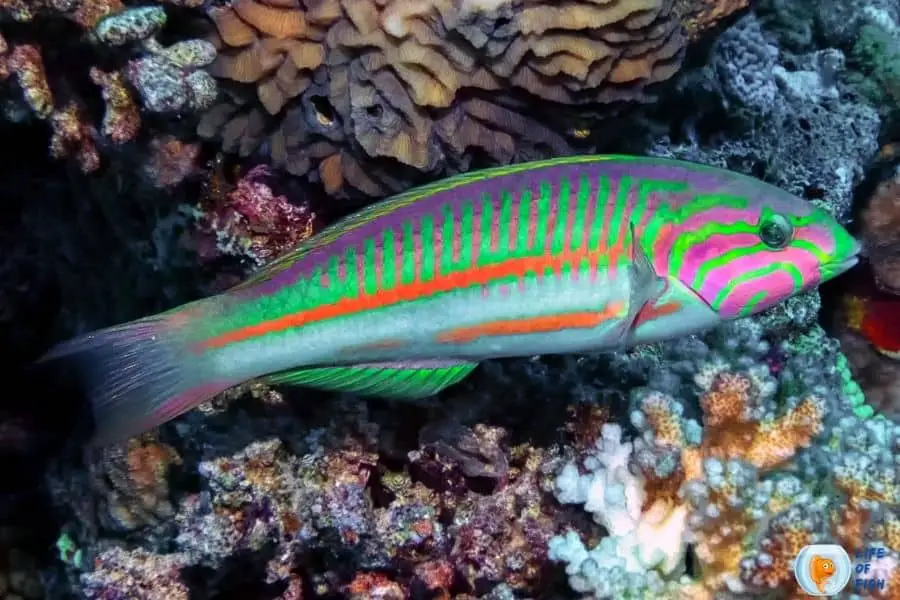Thalassoma rueppellii is known as Klunzinger’s Wrasse commonly among the aquatic community. As its common name suggests, it belongs to the wrasse family.
Their name comes from a combination of two Greek words”Thalassa” and “soma” which means it carries the colors of the sea.
They are a very expensive and rare find in the aquatic industry. However, you won’t regret the amount you have paid, as the outstanding appearance of Thalassoma rueppellii adds extra beauty to your aquarium.

Not only for its appearance but also Thalassoma rueppellii are hardy, easy to maintain, and long-lived species.
Their beautiful and vivid coloration, retains throughout their life journey, as a juvenile, initial and adult stages, with the addition of dark fringing on the fins in secondary males.
Basically, they have green to the bluish body. There are three horizontal lines on its body. Among them, one mid-body stripe and lower body stripe are red in color, while the other along with the top t can be red to purplish.
There are several red to purple vertical markings between the top two stripes. Their heads also have bold irregular markings /stripes of red to pink.
Thalassoma rueppellii belong to the Labridae family and to the genus of Thalassoma. The genus Thalassoma is native to the Atlantic, Indian, and Pacific Oceans and has a number of species in it.
Thalassoma rueppellii is first discovered by Kluzinger in1871 from the Red sea and it is a native species to the Red sea area.
It inhabits the margins and seaward slopes of reefs at depths from 1 to 30 m (3.3 to 98.4 ft). They are categorized under the least concern category and not listed on IUCN Red List.
How big do Thalassoma rueppellii get?
Jump To
- 1 How big do Thalassoma rueppellii get?
- 2 Is Thalassoma rueppellii aggressive?
- 3 Thalassoma rueppellii behavior
- 4 How long do Thalassoma rueppellii s live?
- 5 One look Care guide
- 6 Thalassoma rueppellii care
- 7 Thalassoma rueppellii breeding
- 8 Special tips
- 9 Feeding behavior of Thalassoma rueppellii
- 10 What fish can live with Thalassoma rueppellii?
- 11 Related questions
They are medium-sized species and they can reach the maximum length of 20 cm (approximately 8 inches) in the wild.
But in captivity, the maximum reported length is 7 inches while it is ranged from 6 to 7 inches (15-18 cm).
Is Thalassoma rueppellii aggressive?
They are semi-aggressive species. They are not compatible with smaller fish species and tend to eat them.
The secondary males are more aggressive than the juveniles and females. However, most of the time they are very peaceful and do not bother other fish if not provoked by external factors such as less space.
Thalassoma rueppellii behavior
Juveniles are sometimes seen in groups in their natural environment.
However, the adults rarely form groups, they love to stay alone or in small loose groups. Their small loose groups consist of several females with one dominant male.
Although they are peaceful on many occasions, they can be aggressive to similar size species.
They also show their anger toward slow-moving and small fish species. This wrasse harasses them which sometimes may end up with the death of the other species.
They are highly active species and need plenty of space. Experts say regular feeding, plenty of hiding places, and a lot of space can alleviate aggressive behavior to some degree.

How long do Thalassoma rueppellii s live?
Their lifespan is not known, but they can live a fairly long time in aquariums.
One look Care guide
| Scientific name | Thalassoma rueppellii |
| Common name | Kruzinger’s wrasse |
| Care level | Intermediate |
| Native to | Red sea |
| Type | Reef fish |
| Color | Green to the bluish body with red and purple stripes, yellow fins |
| Tank size | 100 galloon tank |
| Preferred temperature | 72 – 82°F (22 – 27°C). |
| Other water parameters | pH :8.0 – 8.5 |
| Preferred salinity | 1.020-1.025 |
| Size | 8 inches in the wild,6-7 inches in the aquarium |
| Growth rate | Rapid |
| Temperament | Semi-aggressive |
| Recommended tank mates | Groupers Angelfishes Hawkfishes Moderately aggressive triggerfishes |
| Preferred food | Invertebrates and smaller fish in wild brine shrimp, thawed chopped raw fish, small crustacea, frozen foods, flake foods. |
| Feeding frequency | Two to three times a day |
| Breeding | Egg layers, are not known for the breed in captivity |
Thalassoma rueppellii care
Thalassoma rueppellii size
They grow for 20 cm (8 inches ) in the wild. But they are not reaching their maximum length when they are kept in captivity and the maximum length in captivity is 6-8 inches.
Thalassoma rueppellii tank size
Despite their size, they need a large aquarium because they are an active species and love to swim around the aquarium.
The minimum recommended tank size is 75 gallons ( (284 liters) for juveniles. When they grow up you should transfer them to a larger tank preferably 100 gallons.
How many Thalassoma rueppellii should be kept together?
Actually, they are aggressive towards their own species. However, it is advised to keep only one male of this species in one aquarium.
Tank setup
Thalassoma rueppellii need ample space to swim and they dwell in almost all the parts of the tank. , it is good to replicate their natural environment in the aquarium to keep your fish happy.
However, many aquarists suggest that they are not suitable for reef tanks as it eat snails and small crustaceans on reefs.
As they are reef fish, keeping rocks in the aquarium is good. They prefer a sandy substrate of fine sand (0.5 – 2.0 mm).
The sand bed should be at least 4 inches deep for juveniles. They quickly burrow into the sand or hide behind rockwork when frightened.
They occasionally sleep in the sand at night.Thalassoma rueppellii favors plenty of hiding places and you can add rocky caves, flat rocks, and crevices to hunt or sleep.
However, you may need to rearrange the rocks and other bottom decorations from time to time as this species upside down your decorations in their search for bottom-dwelling invertebrates.
Root plants are not a good choice for their tank as they always dig the substrate as a habit. However, if you need to keep root plants, use a pot to secure them from the wrasses.
It is important to keep those decorations on the perimeter of the tank to allow the wrasses to swim freely.
They do not have special light requirements, but they enjoy patches of sunlight.
Giving them the right tank conditions will ease their anger and also it is important for the healthy growth of the fish.
Like many wrasse species, they are good jumpers. Hence, need to use a canopy for your aquarium. They will escape from even a small space, and therefore make sure your canopy does not have even a small space.
Water quality condition
Thalassoma rueppellii are a hardy fish type that can thrive even in certain deviations of the water quality.
The pH of the aquarium water should be in the range of 8.0 – 8.5 while the recommended specific gravity range is 1.020 – 1.026.
Since they live a few meters away from the water surface in their natural environment, they get a temperature of 72 – 82°F (22 – 27°C).
They can tolerate up to 83° F (28°C). Though they can thrive in temperatures a few degrees lower than this, it is better to keep your fish within this range. If you are in a cold environment consider a water heater to keep the relevant temperature.
Use a filter that is suitable for the size of your aquarium. Normal water changes at 10% biweekly or 20% monthly is enough.

Thalassoma rueppellii breeding
Thalassoma rueppellii male or female identification
Although they show sexual dimorphism, it is less noticeable than many other wrasse species.
The only distinguishable feature is that the coloration of fringing on the fins of adult females is slightly pale than the males.
However, the juveniles, despite their gender, also show pale coloration. Therefore male and female identification only can be done in adults.
Like many wrasses, they are also hermaphrodite species.
All the Kruzinger’s wrasses are born as females and when they grow up, the most dominant female wrasse turns into a male and after it leads the group. Their groups consist of one male with 3-4 female wrasses.
Thalassoma rueppellii breeding
They are an egg-laying species. They show distinct pairing during the breeding. Their tiny eggs are released into the water and, they get hatched with the help of the ocean currents.
Once the larvae have hatched, settle on the ocean floor until the free swim fry comes out. They spend their larval planktonic phase almost two months.
However, no reported breeding examples in captivity.
In the wild, they breed with few species under the Thalassoma genus. For an example, the Thalassoma ruepellii can hybridize with Thalassoma lunare and Thalassoma quinquevittatum.
Special tips
Kruzinger’s wrasse is a type of cleaner fish. They are able to remove parasites from other fish.
Though it does not has a great impact on a large outbreak of marine ich (Cryptocaryon), it contributes towards keeping fish parasite free.
The experts advise not to add fish that are already weakened through other causes to the aquarium where these wrasses live.
Because constant cleaning can cause to increase the stress of other fish and may die because of the high stress.
Feeding behavior of Thalassoma rueppellii
What do they eat?
They are carnivorous and they feed on different invertebrates such as snails, tubeworms, sea stars, cucumbers, urchins, crabs, and shrimp.
They also and will also eat smaller fish and sometimes they eat fish that are a little bit larger than their size by first grabbing them and then bashing them against hard objects.
After they consume their prey piece by piece. They mainly focus on the bottom-dwelling creatures, although occasionally they eat fish too.
They have very hearty appetites and therefore, are easily trained to eat prepared food in the aquarium.
Their food should include plenty of proteins. They are fine with food varieties such as small crustacea, formulas, and frozen foods such as mysis and brine shrimp, thawed chopped raw fish, and even flake foods.
They will find their own foods, such as snails when they get used to the tank.
How often should you feed?
They are heavy eaters. Therefore they need to be fed two to three times a day.
The feeding frequency may be decreased as they settle well in the aquarium. Because they can find their own food such as small snails from the aquarium.
When should you feed them?
As they are diurnal fish, need to feed them during day time
How long they can go without food
They are heavy eaters and need food multiple times a day, they cannot thrive a long time without food.
However, when they get settled down in your aquarium, they can survive with the foods available such as snails in the aquarium.
However, keep an eye on them if you are not feeding them, as they may die of starvation if they could not find enough food.

What fish can live with Thalassoma rueppellii?
Thalassoma rueppellii are semi-aggressive species. They are aggressive toward their own species, especially during their breeding season.
They become territorial during that season and become more aggressive than they were. Smaller fish and slightly larger fish than the Kruzinger’s wrasse cannot be kept together as they consider the other species as their food.
However, they do well in community tanks with other species that are considerably larger than them.
Preferable tankmates are those that are larger and somewhat aggressive species, such as groupers, angelfishes, hawkfishes, and moderately aggressive triggerfishes.
Further, Do not put them together with peaceful or docile fish species.
Related questions
Is Thalassoma rueppellii aggressive?
They are moderately aggressive fish and they are aggressive towards other fish species, especially species that are smaller than them. They try to attack the slow-moving species too.
Can Thalassoma rueppellii live in a pond?
Since they are hardy fish species, they can tolerate the change in their environment. Therefore, they can live in ponds. However, they are good jumpers and if you put them in an open pond they will jump away.
Read Next : Dwarf Pea Puffer Care | Tiny Yet Competitive Fish |
